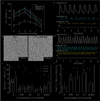Tough and flexible CNT-polymeric hybrid scaffolds for engineering cardiac constructs
- PMID: 24927679
- PMCID: PMC4114042
- DOI: 10.1016/j.biomaterials.2014.05.014
Tough and flexible CNT-polymeric hybrid scaffolds for engineering cardiac constructs
Abstract
In the past few years, a considerable amount of effort has been devoted toward the development of biomimetic scaffolds for cardiac tissue engineering. However, most of the previous scaffolds have been electrically insulating or lacked the structural and mechanical robustness to engineer cardiac tissue constructs with suitable electrophysiological functions. Here, we developed tough and flexible hybrid scaffolds with enhanced electrical properties composed of carbon nanotubes (CNTs) embedded aligned poly(glycerol sebacate):gelatin (PG) electrospun nanofibers. Incorporation of varying concentrations of CNTs from 0 to 1.5% within the PG nanofibrous scaffolds (CNT-PG scaffolds) notably enhanced fiber alignment and improved the electrical conductivity and toughness of the scaffolds while maintaining the viability, retention, alignment, and contractile activities of cardiomyocytes (CMs) seeded on the scaffolds. The resulting CNT-PG scaffolds resulted in stronger spontaneous and synchronous beating behavior (3.5-fold lower excitation threshold and 2.8-fold higher maximum capture rate) compared to those cultured on PG scaffold. Overall, our findings demonstrated that aligned CNT-PG scaffold exhibited superior mechanical properties with enhanced CM beating properties. It is envisioned that the proposed hybrid scaffolds can be useful for generating cardiac tissue constructs with improved organization and maturation.
Keywords: Carbon Nanotubes (CNTs); Cardiac tissue engineering; Cardiomyocyte; Poly(glycerol sebacate):gelatin; Scaffold.
Copyright © 2014 Elsevier Ltd. All rights reserved.
Figures




Similar articles
-
PGS:Gelatin nanofibrous scaffolds with tunable mechanical and structural properties for engineering cardiac tissues.Biomaterials. 2013 Sep;34(27):6355-66. doi: 10.1016/j.biomaterials.2013.04.045. Epub 2013 Jun 6. Biomaterials. 2013. PMID: 23747008 Free PMC article.
-
Moldable elastomeric polyester-carbon nanotube scaffolds for cardiac tissue engineering.Acta Biomater. 2017 Apr 1;52:81-91. doi: 10.1016/j.actbio.2016.12.009. Epub 2016 Dec 8. Acta Biomater. 2017. PMID: 27940161
-
Hybrid hydrogel-aligned carbon nanotube scaffolds to enhance cardiac differentiation of embryoid bodies.Acta Biomater. 2016 Feb;31:134-143. doi: 10.1016/j.actbio.2015.11.047. Epub 2015 Nov 24. Acta Biomater. 2016. PMID: 26621696
-
Carbon nanotube scaffolds as emerging nanoplatform for myocardial tissue regeneration: A review of recent developments and therapeutic implications.Biomed Pharmacother. 2018 Aug;104:496-508. doi: 10.1016/j.biopha.2018.05.066. Epub 2018 May 25. Biomed Pharmacother. 2018. PMID: 29800914 Review.
-
Exploring the effectiveness of incorporating carbon nanotubes into bioengineered scaffolds to improve cardiomyocyte function.Expert Rev Clin Pharmacol. 2020 Dec;13(12):1347-1366. doi: 10.1080/17512433.2020.1841634. Epub 2020 Oct 30. Expert Rev Clin Pharmacol. 2020. PMID: 33103928 Review.
Cited by
-
Conductive 3D nano-biohybrid systems based on densified carbon nanotube forests and living cells.J Mater Res. 2024;39(1):137-149. doi: 10.1557/s43578-023-01163-x. Epub 2023 Oct 25. J Mater Res. 2024. PMID: 38223564 Free PMC article.
-
Biomimetic Scaffolds for Regeneration of Temporomandibular Joint Disc: A Narrative Review.J Dent (Shiraz). 2024 Jun 1;25(2):108-117. doi: 10.30476/dentjods.2023.97625.2024. eCollection 2024 Jun. J Dent (Shiraz). 2024. PMID: 38962074 Free PMC article. Review.
-
Recent Advances in Designing Electroconductive Biomaterials for Cardiac Tissue Engineering.Adv Healthc Mater. 2022 Jul;11(13):e2200055. doi: 10.1002/adhm.202200055. Epub 2022 May 7. Adv Healthc Mater. 2022. PMID: 35368150 Free PMC article. Review.
-
Magnetic-Responsive Carbon Nanotubes Composite Scaffolds for Chondrogenic Tissue Engineering.Adv Healthc Mater. 2023 Dec;12(30):e2301787. doi: 10.1002/adhm.202301787. Epub 2023 Sep 17. Adv Healthc Mater. 2023. PMID: 37660271 Free PMC article.
-
Carbon Nanotube-Based Scaffolds for Cardiac Tissue Engineering-Systematic Review and Narrative Synthesis.Bioengineering (Basel). 2021 Jun 9;8(6):80. doi: 10.3390/bioengineering8060080. Bioengineering (Basel). 2021. PMID: 34207645 Free PMC article. Review.
References
-
- Chien KR, Domian IJ, Parker KK. Cardiogenesis and the complex Biology of regenerative cardiovascular Medicine. Science. 2008;322:1494–1497. - PubMed
Publication types
MeSH terms
Substances
Grants and funding
- R01 EB012597/EB/NIBIB NIH HHS/United States
- HL092836/HL/NHLBI NIH HHS/United States
- EB012597/EB/NIBIB NIH HHS/United States
- DE019024/DE/NIDCR NIH HHS/United States
- R01 HL092836/HL/NHLBI NIH HHS/United States
- EB008392/EB/NIBIB NIH HHS/United States
- DE021468/DE/NIDCR NIH HHS/United States
- R01 DE021468/DE/NIDCR NIH HHS/United States
- HL099073/HL/NHLBI NIH HHS/United States
- R01 AR057837/AR/NIAMS NIH HHS/United States
- R01 HL099073/HL/NHLBI NIH HHS/United States
- AR057837/AR/NIAMS NIH HHS/United States
- RL1 DE019024/DE/NIDCR NIH HHS/United States
- R01 EB008392/EB/NIBIB NIH HHS/United States
LinkOut - more resources
Full Text Sources
Other Literature Sources
Miscellaneous

